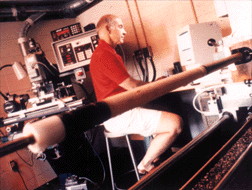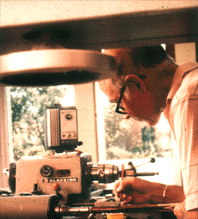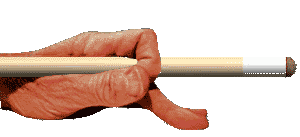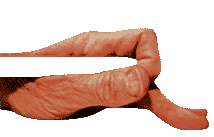.

His Macintosh computer is talking to the automated controls of his industrial milling machine, discussing in machinese some intricate inlay work on the butt of a pool cue Stroud is making for a customer. Stroud is standing by to make sure the machines get it right.
Inside the Mac, Stroud has programmed instructions for how the milling machine is to go about cutting the slots for more than 1,000 inlay patterns that he has designed. Electronic pulses from one of these programs are now directing the Summit machine controller mounted atop the milling machine. In response to the commands from the Mac, the control unit directs the milling machine's tiny router bit to drop, and as it does, the bit begins chewing into the tapered cylinder of ebony clamped onto its work stand.
Then, as Stroud watches, the tiny blade, whirling at 25,000 revolutions per minute, begins cutting a one-half-inch-long slot, exactly one hundred-thousandths of an inch deep and 32-thousandths of an inch wide. Next, as Stroud waits, the blade retracts, the machine obediently rotates the ebony cylinder precisely 90 degrees and the blade cuts another, identical, slot. Just about every morning, Stroud steps onto the Pirelli rubber-tiled floor of his shop and seeks to achieve perfection in the three or four cue sticks he produces each week for his customers. A good cue, he says, "must have a solid feel to it. A cue with a rattle or a click or a vibration or a clink will not be solid feeling-and they're about 80 percent of the cues in the world. You can look at a cue and tell it's poorlv made-but not whether it will play well. Not until you play with it can you tell if it's a piece of wood or a cue. I expect all my stuff to be perfect."
Stroud's sticks are magnificent weapons, magical scepters with exotic hardwoods so highly polished the grains seem infinitely deep, the way some marble is deep; flawless joinery that would do credit to a harpsichord; inlays as filigreed as a Turkish rug, as finely fitted as the tilework on a Pompeian floor or a mosque wall. And still he tests them, despite their stereognostic beauty, ruthlessly.
Inside the Bowl-Mor Lanes not far from his home, Stroud sets his brand-new box of brilliantly colored Super Crystalate balls down on the table and scatters them, a bright spatter of red, green, brown, yellow, blue, across the green felt. He parks the box under the table along with his cellular phone-ever handy to receive orders from his worldwide clientele-and screws together a brand-new cue, one he made for himself. He is trying his hand at snooker-a close relative of pool. He strides around the table with quick, purposeful steps. He quickly lines up his shots, his elbow motionless, a steady fulcrum for his pistonlike wrist, his grip on the butt of the cue far back on the linen wrap. His stroke is sharp and smooth, the cue gliding across the open bridge between his left thumb and the knuckle of his index finger.
 But he misses. Again and again, he misses. He's been so absorbed in the art and science of cue making that he has not shot billiards or pool for nearly a year. Used to testing cues on his living room rug, Stroud has gotten rusty. "That's 'just the way the balls are going to go, I guess," he says. "It'll take me hours to get to where 1 can make a few balls. I'm on a different planet. But this cue feels great! "How does he know?" I put on the shaft and listened for the sound. I heard and felt the feel." Just to be sure, Stroud picks up a pool ball, slightlv larger and heavier than the snooker balls, changes shafts and takes another stroke.
But he misses. Again and again, he misses. He's been so absorbed in the art and science of cue making that he has not shot billiards or pool for nearly a year. Used to testing cues on his living room rug, Stroud has gotten rusty. "That's 'just the way the balls are going to go, I guess," he says. "It'll take me hours to get to where 1 can make a few balls. I'm on a different planet. But this cue feels great! "How does he know?" I put on the shaft and listened for the sound. I heard and felt the feel." Just to be sure, Stroud picks up a pool ball, slightlv larger and heavier than the snooker balls, changes shafts and takes another stroke.
"There was a cold click," he says approvingly; "it could have had too much vibration."
Stroud will use this new beauty in an upcoming gathering of snooker enthusiasts and then sell it. The stick, masterpiece of the cuemaker's art that it is, will go for around $5,000.
All of Stroud's cues can be used in either billiards or pool, the two similar but devilishly different forms of this peculiarly addictive self-torture that began to be played, some historians believe, as Paille Maille around the year 1250. Carom billiards, or just plain billiards, as it is usually called, is an utterly useless and intoxicatingly difficult branch of the game, demanding com-plex mental trigonometry as the cue stick is used to bank a cue ball off three or more cushions (sides of the table) and hit two object balls in varying sequences. Pocket billiards, or pool, so called for the halls where players pooled money for the stakes, is the other branch, an equally beguiling and mysteriously satisfy-ing endeavor involving multicolored smaller balls and a cue stick. In pool, you win by knocking the cue ball into object balls and making them fall into pockets, positioned in the corners and midway down the two long sides of the table. Variations of the two games are myriad, as diverse as the mind's capacity to torture itself with challenging problems in spherical trigonometry, geometry, psychology and Zen. So much Zen, in fact. that the late Zen scholar Alan Watts once called the game "Zilliards
The ex-hustler whose pool cues are a fine art.





